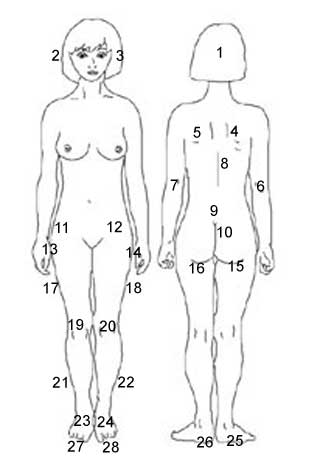
Definition
Pressure Sores (also known as bedsores or decubitus ulcers) are ulcers of the skin (due to pressure) causing a lack of blood supply to the area.
How do they develop?
Pressure ulcers occur when pressure is applied to the same area of the body for an extended length of time. The skin has a rich blood supply that delivers oxygen to all its layers. This pressure prevents blood travelling to the area and restricts the flow of oxygen, causing body tissue to die.
If that blood supply is cut off for more than 2 or 3 hours, the skin dies, beginning at its outer layer (the epidermis). The dead skin breaks down and forms an open sore or ulcer. Once the skin is broken, bacteria may cause an infection.
Pressure sores can cause pain, illness, reduced self esteem and delay rehabilitation efforts making it harder to return to independence.
Where do they develop?
Pressure ulcers tend to develop on areas of the body that have bony projections where pressure is concentrated, such as the hips, heels, shoulder blades and the small of the back. They may occur where pressure from a bed, wheelchair, cast, splint, or other hard object contacts and presses on the skin. Pressure sores may be painful and can be life threatening.
1. Back of head
2. Right ear
3. Left ear
4. Right scapula
5. Left scapula
6. Right elbow
7. Left elbow
8. Vertebrae (upper-mid)
9. Sacrum
10. Coccyx
11. Right iliac crest
12. Left iliac crest
13. Right trochanter (hip)
14. Left trochanter (hip)
15. Right ischial tuberosity
16. Left ischial tuberosity
17. Right thigh
18. Left thigh
19. Right knee
20. Left knee
21. Right lower leg
22. Left lower leg
23. Right ankle (inner or outer)
24. Left ankle (inner or outer)
25. Right heel
26. Left heel
27. Right toe/s
28. Left toe/s

What happens if untreated?
Unrelieved pressure on an area of the body will affect the blood supply to the skin and underlying tissues causing that area to become damaged. Mild tissue damage results in skin discolouration, giving a brown or purple appearance. This may look darker if the skin is very fair. More severe damage can expose muscle and even bone. The area around the dead tissue will look red and inflamed and may become infected. For most people, pressure sores cause some pain and itching. However, in people whose senses are dulled, even severe, deep sores may be painless.
Infection delays healing of minor sores and can be life threatening in deeper sores. Infection can even enter the bone, requiring weeks of treatment with antibiotics. In the most severe cases, infection can spread into the bloodstream. Signs of infection include an unpleasant smell coming from the sore and warm or swollen skin around the area.
Pressure sore categories
Pressure sores are categorised into 4 stages of severity:
- Grade 1 – reddened skin which persists for more than 30 minutes after pressure has been relieved.
- Grade 2 – superficial skin damage. May present as a blister or as an abrasion.
- Grade 3 – full thickness skin loss not extending to bone or muscle. This grade is not usually painful.
- Grade 4 – full thickness skin loss with extensive tissue damage through muscle and bone.
With higher stages of ulcer, healing time is prolonged. While about 75% of stage 2 ulcers heal within 8 weeks, only 62% of stage 4 pressure ulcers ever heal, and only 52% heal within one year (Thomas et al., 2005).
SupaSupport pressure relief systems minimise cross infection and hygiene problems which have recently become major issues facing Health Service providers across Europe. Systems are available in a range of materials and support levels to provide maximum comfort.

